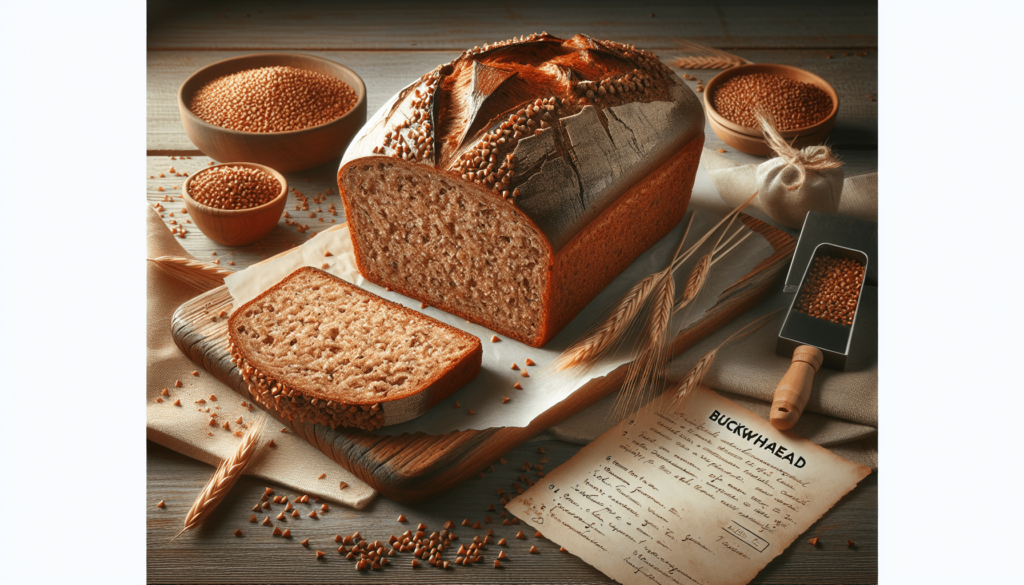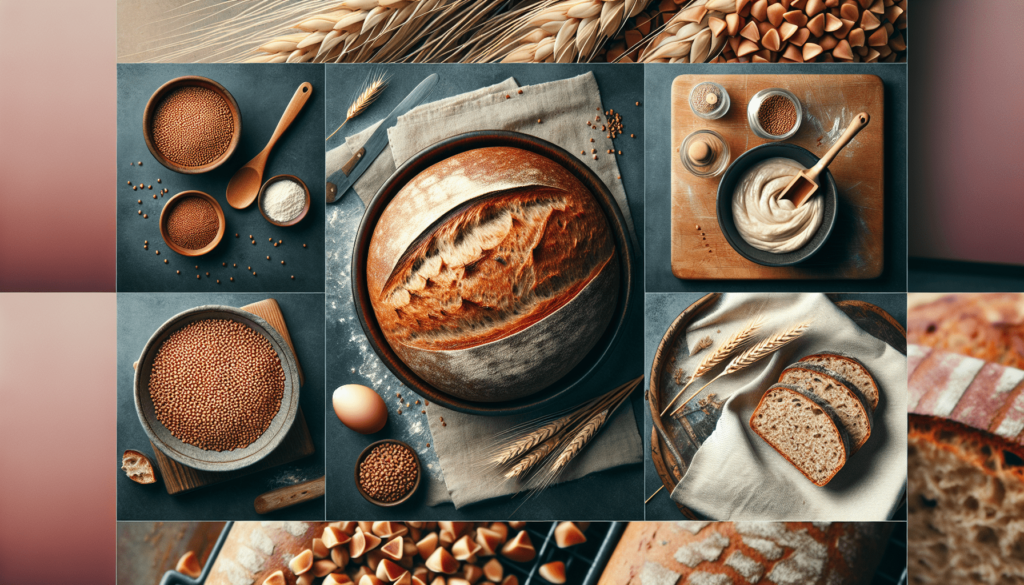If you’re looking to spice up your baking routine with a unique and flavorful bread, look no further than this delightful Buckwheat Bread Recipe. Made with the versatile and nutritious gluten-free grain, buckwheat, this homemade bread not only tastes amazing but is also a great option for those with dietary restrictions. With its soft and moist texture, combined with the rich nutty flavor of buckwheat, this bread is sure to become a staple in your kitchen. Get ready to embark on a baking adventure and create a loaf that will leave your taste buds craving for more.
Ingredients
To make a delicious buckwheat bread, you will need the following ingredients:
Buckwheat flour
Buckwheat flour is the star of this recipe. It has a slightly nutty flavor and a distinct texture, making it a perfect choice for bread.
Active dry yeast
Yeast is an essential ingredient in breadmaking. It helps the dough rise and gives the bread its light and airy texture. Active dry yeast is readily available in most grocery stores.
Warm water
Warm water is needed to activate the yeast. Make sure the water is not too hot, as it can kill the yeast.
Honey
Honey adds a touch of sweetness to the bread and also helps feed the yeast. It provides a natural source of sugar for the yeast to ferment.
Olive oil
Olive oil adds moisture and richness to the bread, giving it a delicious flavor. You can also use other types of oil if you prefer.
Salt
Salt enhances the flavor of the bread and helps regulate the yeast fermentation process. It is an essential ingredient that should not be skipped.
Preparation
Now that you have gathered all the necessary ingredients, let’s dive into the preparation process. Follow these steps to create a scrumptious buckwheat bread:
Activate the yeast
In a small bowl, combine the warm water, honey, and active dry yeast. Stir gently until the yeast is dissolved. Let it sit for about 5 minutes until the mixture becomes frothy and bubbles form on the surface. This indicates that the yeast is active and ready to be used.
Mix dry ingredients
In a large mixing bowl, combine the buckwheat flour and salt. Stir well to ensure the salt is evenly distributed throughout the flour.
Add wet ingredients
Pour the yeast mixture and olive oil into the bowl with the dry ingredients. Mix everything together until a sticky dough forms. If the dough feels too dry, you can add a little more warm water, a tablespoon at a time.
Knead the dough
Transfer the dough onto a lightly floured surface and knead it for about 10 minutes. Kneading helps develop the gluten in the bread, resulting in a better structure and texture. The dough should become smooth and elastic.
Let the dough rise
Form the dough into a ball and place it back into the mixing bowl. Cover the bowl with a clean kitchen towel and let the dough rise in a warm place for about 1 to 2 hours, or until it has doubled in size. This process allows the yeast to ferment and produce carbon dioxide, causing the dough to expand.
Shape the dough
Once the dough has risen, gently punch it down and transfer it to a lightly floured surface. Shape it into a loaf or any desired shape. You can also divide the dough into smaller portions to make individual rolls.
Let it rise again
Place the shaped dough onto a baking sheet lined with parchment paper. Cover it with the kitchen towel again and let it rise for another 30 minutes to an hour. This second rise helps achieve a lighter bread with a pleasant texture.
Bake the bread
Preheat your oven to 375°F (190°C). Once the dough has finished its final rise, place it in the preheated oven and bake for approximately 30-35 minutes, or until the crust is golden brown. To check if the bread is done, tap the bottom of the loaf – it should sound hollow.

Tips and Variations
Making buckwheat bread opens up endless possibilities for customization. Here are some tips and variations to consider:
Adding seeds or nuts
For added texture and flavor, you can incorporate various seeds, such as sunflower seeds, flaxseeds, or chia seeds, into the bread dough. You can also experiment with chopped nuts like walnuts or almonds.
Substituting honey with maple syrup
If you prefer a different sweetener, you can replace the honey with maple syrup. This substitution will give the bread a unique taste and a hint of maple flavor.
Using different flours
While buckwheat flour is the star ingredient, you can also experiment with other flours. Combining buckwheat flour with whole wheat or all-purpose flour can yield different flavors and textures.
Adding herbs or spices
To spice things up, consider adding herbs or spices to your buckwheat bread. Rosemary, thyme, or garlic powder can add an aromatic touch, while cinnamon or nutmeg can give the bread a cozy, warming flavor.
Making a gluten-free version
Buckwheat flour is naturally gluten-free, making it an excellent option for those with gluten sensitivities or celiac disease. You can substitute other gluten-free flours for wheat-based flours to create a fully gluten-free buckwheat bread.
Storage
Once your delicious buckwheat bread is baked and cooled, you may find yourself wondering about the best way to store it for future enjoyment. Here are some tips for storing your bread:
Storing at room temperature
If you plan to enjoy the bread within a few days, storing it at room temperature is ideal. Place the bread in a breadbox or a paper bag to help maintain its freshness. Avoid storing it in a plastic bag or container, as this can make the crust soggy.
Freezing the bread
To extend the shelf life of your buckwheat bread, you can freeze it. Slice the bread before freezing to make it easier to thaw and use as needed. Wrap each slice tightly in plastic wrap or store them in a freezer-safe bag. When you’re ready to enjoy a slice, simply thaw it at room temperature or toast it for a crispy texture.
Reviving stale bread
If your bread has become slightly stale, don’t worry – you can still revive it. Sprinkle the bread with a little water and place it in a preheated oven at 350°F (175°C) for about 5-10 minutes. The moisture from the water and the gentle heat will help freshen up the bread.

Health Benefits
In addition to its delicious taste and versatility, buckwheat bread also offers several health benefits. Here are some of the reasons why this bread is a nutritious choice:
High in nutrients
Buckwheat flour is packed with essential nutrients, including protein, fiber, vitamins, and minerals. It provides a good amount of manganese, magnesium, copper, and phosphorus.
Rich in fiber
Fiber is essential for maintaining a healthy digestive system and promoting regular bowel movements. Buckwheat bread, with its high fiber content, can help support digestive health and keep you feeling full and satisfied.
Gluten-free
Buckwheat is naturally gluten-free, making it a fantastic alternative for those with gluten intolerances or celiac disease. Enjoying buckwheat bread allows individuals on a gluten-free diet to still indulge in delicious homemade bread.
May improve heart health
Studies have shown that buckwheat consumption may help reduce cholesterol levels and improve heart health. The nutrients in buckwheat, including fiber and antioxidants, contribute to its potential cardiovascular benefits.
May help manage diabetes
Due to its low glycemic index, buckwheat bread can be a suitable option for individuals with diabetes. It causes a slower rise in blood sugar levels compared to white bread, which can be beneficial for managing blood sugar levels.
So, whether you’re looking for a tasty gluten-free option, a nutritious bread with a unique flavor, or a bread that may provide health benefits, give this buckwheat bread recipe a try. Enjoy the process of creating your homemade loaf and savor the delicious aroma that will fill your kitchen.


